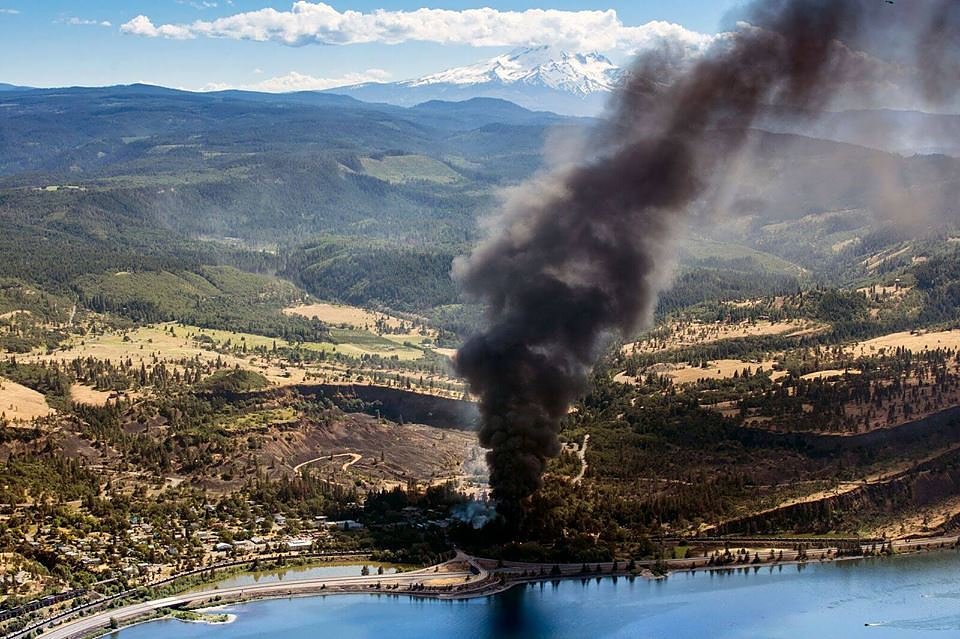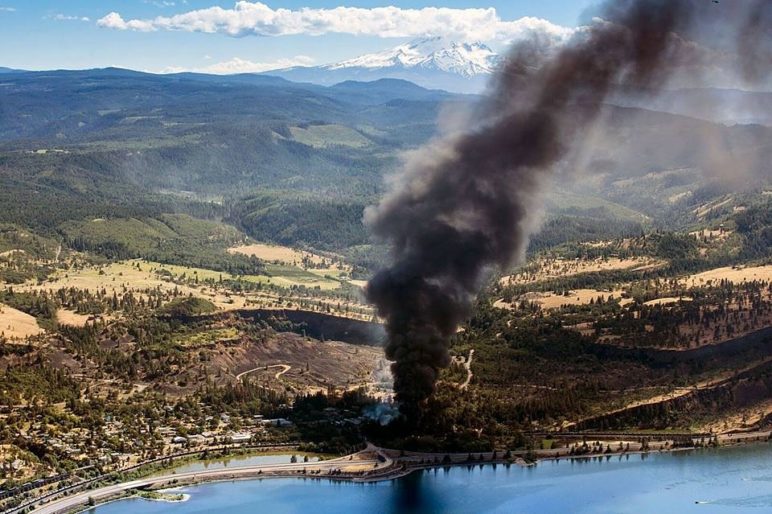It’s been less than three months since the Northwest dodged a bullet. On December 22, 2020, another oil train derailed and exploded into flames, this one just outside Bellingham, Washington. The crash spilled 29,000 gallons of crude oil that burned for eight hours while emergency crews hustled to evacuate neighbors and clean up the site before the oil contaminated groundwater. Yet as alarming as oil train derailments are, they may be only an appetizer for a much more destructive main course: trains loaded with highly explosive liquefied natural gas (LNG).
Why LNG could be heading to a rail line near you
During the Obama years, federal regulators granted railroads in Alaska and Florida limited permission to haul small quantities of LNG on specific routes. Although the move garnered little public attention, it was seen by industry observers as the start of a slippery slope toward broader approval of a cargo that was, until 2015, considered too dangerous for railroads to handle. (DeSmog provides an excellent account of the serious risks of LNG rail transport.) As predicted, in 2020, the Trump administration enacted a new rule allowing rail shipments of LNG, despite criticisms that it lacks safeguards.
The Trump administration’s decision was a win for the gas industry that has found itself increasingly stymied by opposition to building new pipelines. It was also a victory for the rail companies that have for years lobbied for permission to carry LNG, including Union Pacific and BNSF, the dominant railways in Oregon and Washington that have been responsible for several hazardous derailments in the past decade. One of the worst was Union Pacific’s eleven-car derailment in Mosier, Oregon that resulted in a fiery explosion and an oil spill along the Columbia River in 2016. BNSF is responsible for its own oil train conflagrations too, including two North Dakota explosions in 2013 and 2015 that prompted towns to evacuate, a derailment in Illinois in 2015, and the recent explosion in Whatcom County, Washington.
LNG is far more dangerous than crude oil. In fact, experts calculate that it would take only twenty-two tank cars loaded with LNG to hold the energy equivalent of an atomic bomb. That’s not hyperbole. Even a single LNG rail car igniting could level buildings to deadly effect. It’s no wonder, then, that fifteen state attorneys general, including those in Oregon and Washington, have challenged the Trump administration’s approval of LNG trains, stating that it puts people’s lives at risk.
The risk is real, and federal accident statistics bear it out. Trains derailed no fewer than sixty-two times in Oregon and Washington in 2020, including at least fourteen derailments that were carrying hazardous materials. (These statistics almost certainly undercount derailments, a flaw that becomes clear when one realizes that they do not include the fiery oil train derailment in Custer, Washington in late December.)
What’s less understood than the risk to lives and property is the staggering risk to taxpayers. It’s a risk that could prove to be the endeavor’s Achilles’ heel, and it could give the Biden administration a commonsense way to halt LNG rail transport. As it happens, railroads are severely underinsured for many hazardous substance shipments, especially in urban areas, so simply requiring them to carry insurance proportional to the risk would almost certainly render the entire venture uneconomical.
How railroad underinsurance puts taxpayers at risk
In January 2014, The Wall Street Journal published a shocking exposé on how badly underinsured the railroads hauling crude oil really are, and how they would be unable to cover the costs of an oil train explosion in an urban area. The investigation found that in the insurance world, even a catastrophe like the deadly 2013 oil train derailment in Quebec that killed forty-seven people is not considered a truly worst-case scenario accident. What would qualify is something like a derailment in the middle of a densely populated area, like in downtown Spokane where trains filled with volatile crude oil already pass travel regularly. With remarkable candor, industry experts went on record to detail the inadequacy of the insurance railroads carry for such an event.
According to The Wall Street Journal, even if a railroad wanted to buy insurance for a truly catastrophic accident — a 300-foot-tall fireball in Seattle, for example — no one would sell it to them. In other words, if railroads had to carry insurance proportional to the risk of a mishap (like motorists must), they simply would not be able to ship dangerous cargo like LNG. James Beardsley with insurer Marsh & McLennan Companies was blunt: “There is not currently enough available coverage in the commercial insurance market anywhere in the world to cover the worst-case [train derailment] scenario.”
At best, Beardsley says, there is only about $1.5 billion in liability insurance available for even the biggest railroads. This is an amount that would not even cover the damages in a small town. In fact, actuarial estimates find reasonable worst-case hazmat derailments can easily range above $5 billion.
How the Biden administration can insure the safety of communities
As a consequence of the mismatch between financial risk and insurance coverage, each and every rail shipment of LNG would effectively be traveling uninsured against the losses that could result from a catastrophic accident in any of the communities along its route. That’s especially true in the densely-populated urban areas where thousands of buildings and people are located well within the blast zone of a potential conflagration.
States can take steps to protect their communities—and their wallets. Although states are generally prohibited from imposing financial regulations on railroads (because that authority is reserved for the federal government in order to protect interstate commerce), states can do what Washington already does for railroads that haul crude oil: require them to disclose information. States could, for example, require LNG-shipping railroads to share with the public the routes they use and the amount of insurance they carry. These basic facts would allow officials to take steps to protect themselves from the risks, whether physical or financial.
The real power lies with the federal government though. The Biden administration could immediately suspend Trump’s approval of LNG-by-rail operations until officials can conduct a legitimate risk assessment of LNG trains, one with actuarial rigor. Then, based on that assessment, Biden could take the same commonsense approach we use for motorists: require railroads to carry insurance proportional to their risk.
The industry would surely howl. The fact is, a commonsense insurance requirement would almost certainly spell the end of LNG by rail because neither the railroads nor the gas companies can buy enough coverage to protect the public. And even if they could buy it, it would likely be so costly as to make the entire enterprise unprofitable. But if the project they’re backing — running mile-long LNG trains through Northwest cities — can’t be underwritten by private insurance, isn’t that a big red flag that it’s just too dangerous?











John Abbotts
Thanks Eric,
For this article. You have previously called out Warren Buffet, whose Berkshire-Hathaway company buys wind and solar energy companies, but also any other energy form that offers profits, including a stake in a tar sands oil company. Berkshire-Hathaway also owns BNSF railroad, which transports coal, along with “bomb train” oil in its tanker cars, link at https://www.sightline.org/2013/07/10/the-money-behind-fossil-fuel-exports/
Also according to a Grist e-mag article in 2014, Warren Buffett also advocated for the railroad industry insurance protection akin to the Price-Anderson Act for the atomic power industry, whereby the federal government becomes the “insurer of last resort,” for reactor accidents, https://grist.org/climate-energy/exploding-oil-train-owners-want-insurance-slack-just-like-nuclear-power/.
Japan has similar legislation, and their government became liable for the costs of Fukushima, above a threshold set for their atomic power industry. Oh, and Warren Buffet also invests in US atomic power companies.
I have heard Ralph Nader and others [including your own comments above], note that the inability of “ultrahazardous” industries to obtain private insurance, represents an economic obstacle against such ultrahazardous pursuits. The Price-Anderson Act of 1954 [or thereabouts] removed that impediment for atomic power. Readers can watch to see if the Biden administration bows to Warren Buffett and others by offering similar legislation for “extreme energy” producers and transporters.
To paraphrase Naomi Klein in her book “This Changes Everything: Capitalism vs. The Climate.” governments need to learn to say NO to extractive industries.
All stay safe from all science denial threats,
John Abbotts
Ack, to Sightline editors, a typo in he comment I submitted earlier today, Governments need to learn to say NO to extractive industries
Dirk Vermeeren
Thanks for the article and reality check on what can truly happen. What people don’t fully realize that is that accidents will happen, it is the undeniable risk in all operations; they are not totally preventable.
Unfortunately administrations at the federal level change every 4 years, I suggest we in WA state must take on the responsibility of our own state and local communities, become stewards of our local environment. Requiring any/all business’ (refineries, rail, etc.) to carry an adequate level of insurance (Environmental Impairment Liability) coverage for when the accidents do happen will assure their financial revenue model is not justified by a taxpayer bailout when they can declare bankruptcy and walk away letting local communities/taxpayers pay for cleanup costs.